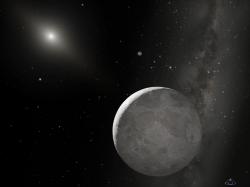Already in previous studies it seems to be larger. The research published this week reinforced this as well as justifying the decision to demote Pluto

Eris and Moon Dysnomia
Pluto's fans, bemoaning his demotion are disappointed again. New data shows that Eris is 27 percent more massive than Pluto, thus reinforcing the opinion of supporters last year of stating that the solar system has only eight planets and a growing list of dwarf planets.
According to Mike Brown, the discoverer of Eris and his doctoral student Emily Schaller, the data shows that the dwarf planet Eris weighs 16.6 billion trillion kilograms. They know this because of the time it takes for the moon of Eris, Dysnomia to complete the coffee. It was Pluto's last chance to prove that it is the largest body discovered in the Kuiper Belt, said Brown, a professor of planetary astronomy at the California Institute of Technology. "There is a possibility that Pluto and Eris are of similar size, but the new results show that Pluto will be second.
Eris was discovered in 2005 with the help of the 48-inch telescope by Samuel Ocean at Mount Plumer Observatory, an instrument specially adapted to carry out comprehensive studies of celestial objects. When Eris was discovered to be similar in size to, if not larger than, Pluto, Brown and others asked the World Astronomical Union to discuss its planetary status. The result was the demotion of Pluto and its classification along with the classification of other Kuiper belt bodies as dwarf planets. Schaller says that the new results obtained with the help of the Hubble Space Telescope and the Keck Observatory indicate that the density of the materials that make up Eris is about 2 grams per cubic meter. This means that Eris is almost certainly composed of ice and rocks, and is therefore very similar in composition to Pluto. Previous results from the Hubble Space Telescope have already led planetary scientists to determine that its diameter is about 2,400 kilometers, larger than the diameter of Pluto. "Pluto and Eris are more or less twins - except that Eris is somewhat fat," says Shaler.
The reason why Eris' surface is swollen is because of its distance from the sun. It is currently 97 AU from the Sun. Eris hovers in an area where the temperature is lower than 200 degrees Celsius and in almost total darkness. However, sometimes conditions change for the better - Eris' 560-year-old orbit is very elliptical and it approaches the Sun as close as 38 astronomical units, but now it is almost at the greatest possible distance. Pluto's elliptical orbit now takes it up to a distance of 50 astronomical units from the Sun during 250 years. This means that Eris is sometimes closer to the Sun than Pluto, but it is never as close as Neptune, unlike Pluto which crosses Neptune's orbit.
Based on the spectral data, the researchers believe that Eris is covered in a layer of frozen methane that came out from under its surface and froze. As in the case of Pluto, the methane underwent chemical transformations, almost certainly due to the pale solar radiation, which caused the methane layer to turn red. However, the methane cover on Eris is more yellow than the reddish-yellow surface of Pluto, possibly due to the fact that Eris is farther from the Sun.
"As for Dysnomia, the only tiny moon discovered orbiting Eris so far is 150 kilometers in diameter and orbits Eris at a distance of 37 kilometers for 16 days. Like the Earth-Moon system, the Eris-Dysnomia system almost certainly formed together 4.5 billion years ago following the massive collapse of the original cloud from which the Solar System formed."
Brown and Schaller published their findings in an article titled: "The Mass of the Dwarf Planet Eris," which appeared on June 15 in the journal Science. The research of the new planets and other bodies in the Kuiper Belt was funded by Caltech and NASA.

3 תגובות
The dwarf is important to be precise.
I didn't get enough explanation about the planet Eris.
I would love to learn about space